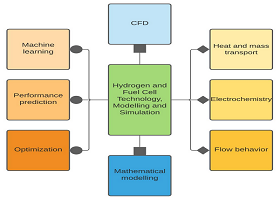Hydrogen and Fuel Cell Technology, Modelling and Simulation
A special issue of Energies (ISSN 1996-1073). This special issue belongs to the section "A5: Hydrogen Energy".
Deadline for manuscript submissions: closed (31 December 2021) | Viewed by 18491

Special Issue Editor
Interests: additive manufacturing; engineering design and manufacturing; crashworthiness, fuel cell technology
Special Issues, Collections and Topics in MDPI journals
Special Issue Information
Dear Colleagues,
Fuel cells are devices that generate electricity through an electrochemical reaction with only heat and water as by-products. Nowadays, fuel cell devices are receiving increased attention as clean energy sources for various practical applications—from small electronic devices to vehicles. Effective design and development of the various components of a fuel cell require an in-depth understanding of the influence of different design variables on the performance of these components. Fuel cell operation involves simultaneous and multiphysics complex processes, and due to the highly reactive, compact nature of the fuel cell, it is challenging to conduct in-situ measurements of critical parameters, such as temperature, pressure and potential gradients, or species concentration. Various computational and modelling techniques, which allow systematic simulation, design, and optimization of fuel cell systems, are valuable tools that provide insight into the phenomena occurring within the cell, reducing the development cycles, and enabling to build the next generation of fuel cells.
Thus, this Special Issue focuses on the recent developments and applications of modelling, simulation, and optimisation tools for the design and development of different types of fuel cell devices.
Dr. Ahmad Baroutaji
Guest Editor
Manuscript Submission Information
Manuscripts should be submitted online at www.mdpi.com by registering and logging in to this website. Once you are registered, click here to go to the submission form. Manuscripts can be submitted until the deadline. All submissions that pass pre-check are peer-reviewed. Accepted papers will be published continuously in the journal (as soon as accepted) and will be listed together on the special issue website. Research articles, review articles as well as short communications are invited. For planned papers, a title and short abstract (about 100 words) can be sent to the Editorial Office for announcement on this website.
Submitted manuscripts should not have been published previously, nor be under consideration for publication elsewhere (except conference proceedings papers). All manuscripts are thoroughly refereed through a single-blind peer-review process. A guide for authors and other relevant information for submission of manuscripts is available on the Instructions for Authors page. Energies is an international peer-reviewed open access semimonthly journal published by MDPI.
Please visit the Instructions for Authors page before submitting a manuscript. The Article Processing Charge (APC) for publication in this open access journal is 2600 CHF (Swiss Francs). Submitted papers should be well formatted and use good English. Authors may use MDPI's English editing service prior to publication or during author revisions.
Keywords
- CFD
- Matlab
- modelling
- simulations
- optimisation
- PEM
- SOFC
- DMFC
- fuel cell





